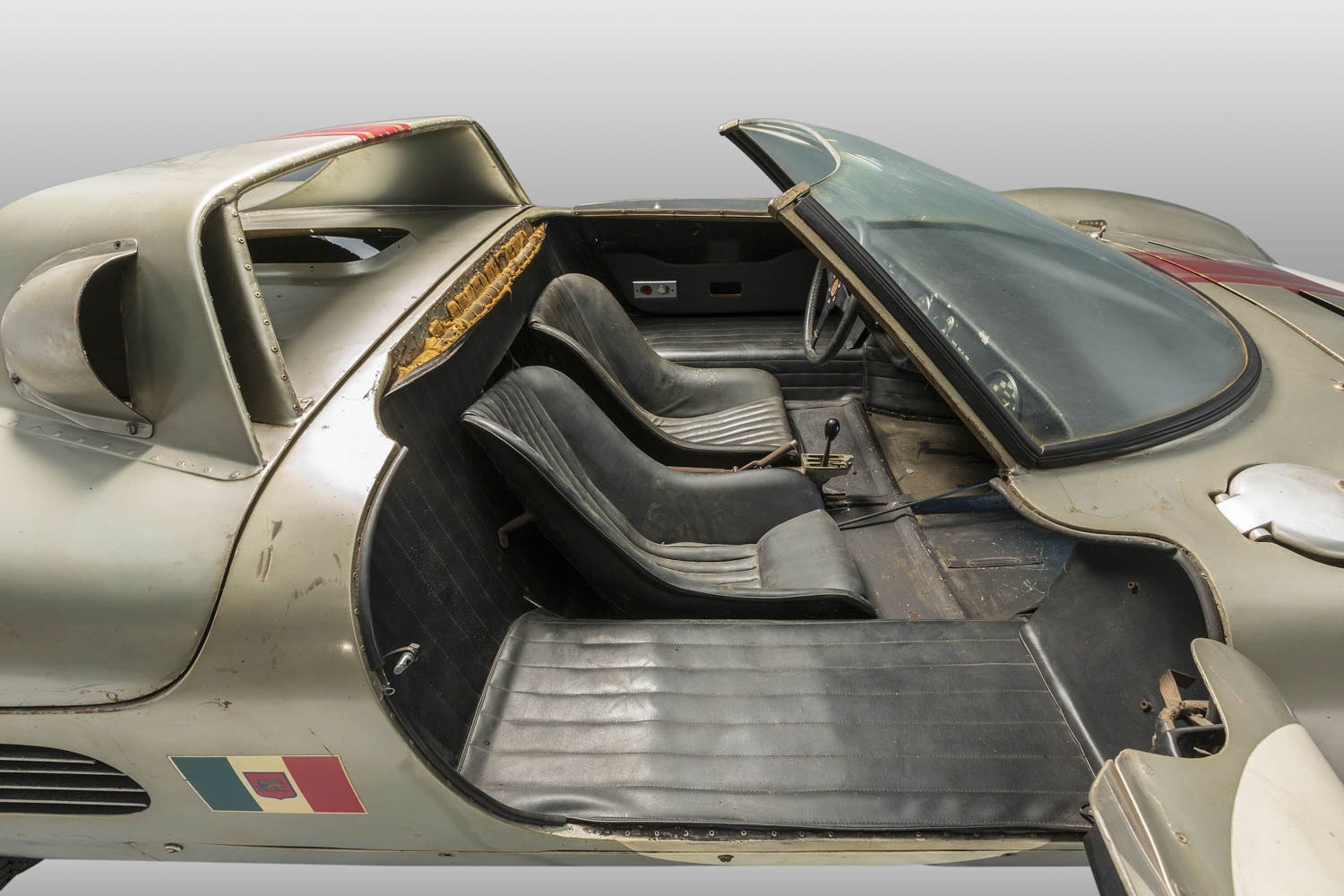Media | Articles
This Serenissima Spyder is a relic of a forgotten 1960s race team
On this gray morning, workers from auction house Artcurial unload treasure after treasure bound for the auction block on February 8 at the Rétromobile classic car show in Paris. Among the stars of the show, one car stands out: an unrestored survivor with fading paint and a constellation of dents betraying the lightweight construction of its body. Already partially disassembled, it exhales faint fumes of old petrol, grease, and dirty oil.
Up to this point the property of Count Volpi, founder of the manufacturer and race team Serenissima, this 1966 Serenissima Spyder appears to have been wheeled straight into storage after the ‘66 Le Mans 24-hour race. The Serenissima hasn’t suffered the patched-up race damage, bodywork alterations, engine swaps, and fumbled restorations which have sullied many other vintage race cars. It is the only surviving Spyder of the pair that were built, and Artcurial’s pre-sale estimate for the car is €1.3M – €1.3M ($1.48M – $2.05M). The car raced just once, at Le Mans in ‘66, and has remained untouched ever since.
In that famous race, all eyes were on the battle of the egos between Henry Ford and Enzo Ferrari. The two automotive titans had spent months negotiating a deal whereby Ford would buy the Italian company so the former could go endurance racing, but Ferrari pulled out at the last minute, unhappy about losing control of his beloved racing team. In truth the Commendatore probably never envisaged his company under the control of the Americans; he wanted to force Agnelli, owner of Fiat, to invest in his firm. Ford hit back with a vengeance, not just aiming to embarrass, but to destroy Ferrari at their favorite playground—Le Mans. For the 1966 race, almost a third of cars entered were Fords, flush with high expectations despite the fact that all of the GT40s had retired from the previous year’s race.

Count Volpi had previously campaigned Ferraris, Maseratis, and a few Porsches wearing his coat of arms. In 1962, however, his relationship with Ferrari soured when he agreed to finance a fifth of a company called ATS. The firm in question was created by some of Maranello’s pariahs following an internal schism at Ferrari 1961 when a number of senior figures departed after serving Enzo an ultimatum: either his wife (who had been involved in running the company) went, or they did. Needless to say, Ferrari stopped providing race cars to Volpi once he cast his lot with ATS.
Marketplace
Buy and sell classics with confidence
Volpi’s relationship with the new company would not last the year, but this impassioned lover of beautiful machines had now caught the scent of glamour which can only attend respected constructors. He had an itch to build something of his own. Girolamo Gardini, who had been Ferrari’s commercial and sports director until he left as part of the 1961 scandal, went to Volpi with designs for a passenger car engineered by Alberto Massimino, whose career had led him from Alfa Romeo to Ferrari via Maserati. In nine months a newly-conceived 3.0-litre V-8 was coming together on the workbench. Three months later, the Serenissima’s wheels turned for the first time.
Massimino designed the tubular chassis and all the mechanical parts, including the gearbox, while the body was penned by Franco Salomone. Following standard practice of the era, the first car was built as a draft, a kind of working prototype and design study. It quickly became a donor for the cars that followed. The second Serenissima, the 308V Jet Berlinetta fashioned by carrozzeria Fantuzzi, was more successful and gave birth to two Spyder variants, one of which is the car headed to Rétromobile. For Volpi, Serenissima was a laboratory, and its road models were capable of being driven by everyone (hence the synchronized gearbox).




The Serenissima Spyder sporting number 24 (with the numbers still visible on the white roundels) entered the ‘66 race at Le Mans with two Frenchmen at the helm, Jean-Claude Sauer and Jean de Mortemart. More than a half-century later, the Dymo labels are still stuck below switches and rockers in an astonishing state of preservation, with each function typed out in French. Unfortunately the adventure was cut short; the Spyder had to bow out of the race with a broken transmission after five hours.
Despite its poor performance, this Serenissima deserves attention. It’s a rare survivor from this largely forgotten manufacturer. The brand and the racing team disappeared in 1970, as competition became more professionalized and rising operational budgets prevented Volpi and Serenissima from being able to keep up with the big teams.
The sale of this Spyder this February is a reminder of how small companies could still compete in racing 50 years ago, one that feels particularly timely in light of the Automobile Club de l’Ouest’s efforts to rein in the outrageous budgets needed to effectively compete at Le Mans. Always rare, the Serenissima has now been transformed by time into something else: precious and serene, indeed.
















